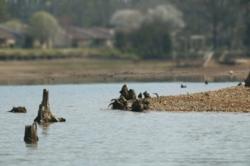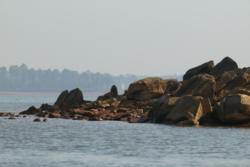Go with the flow

How understanding current turns torpid bass into aggressive feeders
Plus sidebars: ‘Current hot spots’ and ‘Wind currents’
Water currents dramatically influence bass movements, especially in rivers, tidal waters and power-generating reservoirs. Subtle current situations also exist on all bass waters that many anglers overlook. Learn to read and fish currents and you’ll step up to a higher level of bass-fishing success.
Wal-Mart FLW Tour standout Jay Yelas of Tyler, Texas, verified his flowing-water mastery when he won the 2002 Bassmasters Classic on Alabama’s Lay Lake. This Texan concentrated on the tail waters of the Logan Martin Dam.
“When the dam’s turbines were off, bass scattered over shoals and drop-offs in the middle of the river,” Yelas said. “Power generation created a strong current that pushed the bass to the banks.”
A month before the Classic on Lay Lake, Yelas caught 15 to 20 spotted bass a day on Berkley’s Frenzy Popper. He worked the bait over shallow, midriver shoals during slow-water periods. The top-water bite died, however, before the tournament began, and Yelas switched to a Frenzy Medium Diver. Using this lure, he caught slack-water bass about 8 feet deep from midriver ledges during the early morning hours. When water flushed through the turbines, the river rose 3 feet and bass hugged the bank.
 Yelas moved to a 200-yard stretch of shoreline composed of gravel, rock and boulders. He cast a 5/8-ounce jig upstream under overhanging bushes and let the current wash the bait along the bottom. This tactic produced the bulk of Yelas’ catch including two largemouths of more than 6 pounds. His final tally of 45 pounds, 13 ounces was nearly 6 pounds ahead of the runner-up.
Yelas moved to a 200-yard stretch of shoreline composed of gravel, rock and boulders. He cast a 5/8-ounce jig upstream under overhanging bushes and let the current wash the bait along the bottom. This tactic produced the bulk of Yelas’ catch including two largemouths of more than 6 pounds. His final tally of 45 pounds, 13 ounces was nearly 6 pounds ahead of the runner-up.
Ledges
Power-generating dams also move water throughout a reservoir. The current is not as strong as in the tail waters, but bass surely respond to it. When turbines lay idle, bass may spread over main lake-flats. They’ll bite if you’re lucky enough to run a Carolina rig or some other bait in front of them. Bass also suspend above river channels and go into a nonfeeding funk.
The onset of moving water turns torpid bass into aggressive feeders. They cluster along channel ledges, river bends, humps and the junctures of creek and river channels. They’re ready to pounce on baitfish and whatever else the current washes to them.
“I throw a Carolina rig when the water is still,” Yelas said. “When the current gets going, I pick up my crankbait rod. It’s time to load the boat.”
Yelas positions his boat on the downstream side of ledges and other structures and retrieves his crankbaits with the current. He moves his boat to work sweet spots from different angles. Most casts quarter up onto the structure. He also runs crankbaits parallel to the edges of drops. A single stump, snag or brush pile on a ledge may yield several bass. Yelas works such spots hard.
Tidal waters
Bass in tidal water feed heavily during incoming and outgoing tides. The flow draws bass to bridge abutments, snags, boulders, laydowns, points and jetties. These objects provide current breaks where bass may hold just off the edge of the flow. Yelas has repeatedly won piles of cash fishing tidal waters such as the Potomac River.
“I look for man-made rock piles and rocky jetties,” Yelas said. “The current dictates how I fish these places.”
 One of his most productive jetties lies perpendicular to the river’s flow. The top of the jetty uncovers at low tide. High tide inundates the jetty with 3 feet of water. At the onset of a tidal movement, Yelas fishes the side of the jetty facing the current. For example, on a river that runs south, Yelas fishes the north side of the jetty on an outgoing tide.
One of his most productive jetties lies perpendicular to the river’s flow. The top of the jetty uncovers at low tide. High tide inundates the jetty with 3 feet of water. At the onset of a tidal movement, Yelas fishes the side of the jetty facing the current. For example, on a river that runs south, Yelas fishes the north side of the jetty on an outgoing tide.
“Tidal flows begin slowly and gradually increase,” Yelas said. “Initially, bass feed in the current.”
Yelas combs the side of the jetty with a variety of crankbaits that run from 2 to 7 feet deep. He keeps his boat close to the rocks and casts ahead at a 45-degree angle. Most casts dig the crankbaits along the face of the jetty. He also runs a shallow-diving crankbait over the top of the jetty. When the tide peaks, bass duck behind boulders and the jetty to avoid the current.
FLW Tour pro Sam Swett also scores well on tidal waters, especially when he fishes the Louisiana Delta near his home in Covington, La.
“I do best on falling tides,” Swett said. “At high tide, the bass move up into shallow duck ponds that are inaccessible to bass boats. When the tide goes out, the bass gang up in ditches that drain into the main bayou.”
Swett sets up downstream from the mouth of a ditch. He fishes the eddy that forms where water draining from the ditch collides with water flowing out of the bayou. An Excalibur Fat Free Shad or Fat Free Fingerling crankbait usually does the job.
“I cast upstream across the mouth of the ditch and into the ditch,” Swett said. “There’s always one sweet spot where those fish hold. Generally it’s on the downstream side of the ditch where there’s a little slack water.”
In river systems, small tributaries that feed into the main river present a similar situation. Swett uses the same approach that pays off when he cranks a ditch in a bayou.
Wing dams also yield bass to Swett’s crankbaits when he fishes navigable waters such as the Red River. He targets the eddy that forms where water sliding across the face of the wing dam joins the main-river current. Such spots are often easy to see because the swirling eddy collects foam and debris.
Swett holds downstream from the eddy and casts a crankbait upstream beyond the swirl. Then he retrieves with the current. A high-speed 6.3-1 gear ratio Pflueger Trion reel helps him stay ahead of the flow. This is necessary to maintain control of the lure.
“I’ll be cranking, and all of a sudden I’ll feel the crankbait change direction when it hits the eddy,” Swett said. “Usually, right at that moment is when I get a strike.”
This ploy came through for Swett when he fished an FLW Tour event on the Red River. It was late on day one, and Swett was heading back to the weigh-in with only two bass. While waiting for a lock, he cranked the end of a wing dam. By the time the gates swung open, he had landed three 3-pound bass. Wing dams helped him boat enough bass to finish in 13th place.
Current breaks around locks also produce bass for Swett. He runs his crankbaits downstream past pilings, the ends of lock walls, boulders, snags, and points and pockets along the shoreline. This tactic has given up many bass for him.
“I bang my crankbaits into pilings, rocks and anything else that breaks the current,” Swett said. “Combine that contact with the force of the current, and your line really takes a beating. I go with 17- or 20-pound Silver Thread.”
Yelas opts for 12-pound Trilene XT when fishing abrasive cover in fast currents. When he cranks main-lake ledges on power-generating reservoirs, he switches to 10-pound-test Trilene Sensation.
“Sensation is thin,” Yelas said. “It lets my diving crankbaits get down to deep bass. It’s also a low-stretch monofilament, so I can really feel what my bait is doing.”
Timing
Timing is everything when you fish currents. You must be there when the water is moving. Arrive too early or late, and you’ll struggle to get bites. When fishing tidal rivers, invest in tide charts. They tell you when the water flows in or out so you can adjust your schedule to tap the prime times. Experienced tidal-water anglers often follow the tides to stay in touch with feeding bass.
“When I plan to fish a lock or tail water, I find out when water will be released,” Swett said. “I contact the lock master or the U.S. Army Corps of Engineers, depending on who maintains the facility. They can provide this information.”
Related articles:
